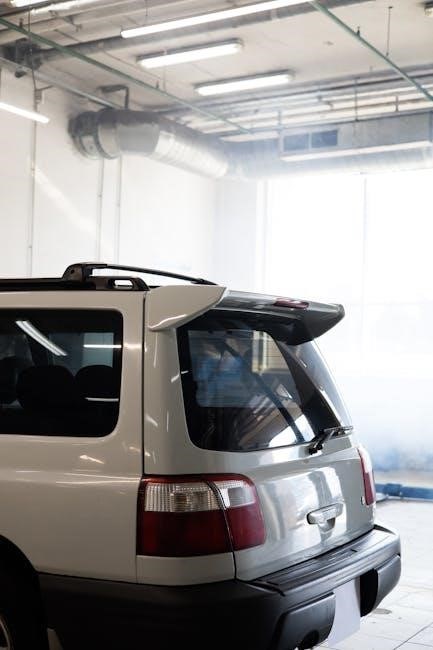Felpro rear main seal installation requires careful attention to detail and proper tools, including a plastic installation tool and gasket material for successful installation always.
Overview of the Installation Process
The installation process of Felpro rear main seal involves several steps, including preparing the surface, choosing the correct seal material, and installing the seal.
The process requires careful attention to detail to ensure a successful installation.
A plastic installation tool and gasket material are necessary for the installation.
The seal must be installed correctly to prevent leaks and ensure proper engine function.
The installation process may vary depending on the vehicle make and model.
It is essential to follow the manufacturer’s instructions and recommendations for the installation.
The process may also require additional tools and materials, such as a valve guide machining tool.
Proper installation of the Felpro rear main seal is crucial for the engine’s performance and longevity, and it is recommended to consult a professional mechanic if unsure.

Preparing the Surface for Installation
Clean and inspect the crankshaft surface carefully before installation always using proper tools and techniques available online now.
Cleaning and Inspecting the Crankshaft
The crankshaft surface must be thoroughly cleaned and inspected before installing the Felpro rear main seal. This involves removing any dirt, debris, or old seal material that may be present. A soft cloth and mild solvent can be used to wipe down the surface, followed by a thorough inspection for any scratches or imperfections. Any damage to the crankshaft can affect the seal’s ability to function properly, so it’s essential to address any issues before proceeding with the installation. By taking the time to properly clean and inspect the crankshaft, you can help ensure a successful installation and prevent any potential leaks or other problems down the line, using proper tools and techniques available online now for reference.

Choosing the Correct Seal Material
Seal materials include Teflon and rubber, each with unique properties and applications always considered during installation processes online now.
Teflon vs. Rubber Seals
When selecting a seal material, it is essential to consider the differences between Teflon and rubber seals. Teflon seals are known for their durability and resistance to wear, making them a popular choice for high-performance applications. On the other hand, rubber seals are often preferred for their ability to conform to irregular surfaces and provide a tight seal. The choice between Teflon and rubber ultimately depends on the specific requirements of the installation and the desired level of performance. By understanding the unique characteristics of each material, individuals can make an informed decision and ensure a successful installation. Proper selection is crucial for optimal results and longevity.

Installation Requirements
Valve guide machining and stem seal installation are necessary steps always required for successful installation processes to begin correctly and efficiently every time.
Valve Guide Machining and Stem Seal Installation
Valve guide machining is a critical step in the installation process, requiring precise measurements and tools to ensure proper fit and function. The stem seal installation is also crucial, as it helps to prevent oil leaks and maintain engine performance. According to the instructions, the valve guide machining should be done with care, using the correct tools and materials to avoid damage to the engine components; The stem seal should be installed carefully, making sure it is properly seated and aligned to prevent any leaks or issues. By following these steps, the installation process can be completed successfully, ensuring a proper seal and optimal engine performance, with the correct tools and materials always being used.
Common Mistakes to Avoid
Incorrect installation and mis-boxed seals can cause leaks and damage, requiring careful attention always and proper tools.
Incorrect Installation and Mis-Boxed Seals
Incorrect installation and mis-boxed seals are common mistakes that can lead to leaks and damage to the engine. According to online forums, some users have reported issues with Felpro rear main seals being mis-boxed, which can cause problems during installation. It is essential to double-check the packaging and ensure that the correct seal is being used. Additionally, improper installation techniques, such as tapping the seal into place, can also cause damage to the seal and lead to leaks. Using the correct tools and following the manufacturer’s instructions can help prevent these mistakes and ensure a successful installation of the Felpro rear main seal. Proper installation is crucial to prevent engine damage and ensure a leak-free seal.
Tips for a Successful Installation
Using correct tools and following instructions ensures successful Felpro rear main seal installation always with proper gasket material and techniques used correctly online.
Using a Plastic Installation Tool and Gasket Material
The use of a plastic installation tool is highly recommended when installing a Felpro rear main seal, as it helps to prevent damage to the seal or surrounding components. Additionally, the correct gasket material should be used to ensure a proper seal and prevent leaks. The plastic installation tool is designed to fit snugly over the seal and guide it into place, making the installation process much easier and reducing the risk of error. By using the correct tool and gasket material, installers can ensure a successful and leak-free installation of their Felpro rear main seal, which is essential for the proper functioning of the engine. Proper installation is crucial to prevent damage and ensure longevity.

Verifying the Seal’s Proper Fit
Verifying the seal’s dimensions and clearance is crucial for proper fit and function always using correct measurement tools and techniques every time perfectly.
Checking the Seal’s Dimensions and Clearance
To ensure a proper fit, checking the seal’s dimensions and clearance is essential. The seal’s width and outer diameter must be measured accurately. Using a precision tool, such as a caliper, can help obtain precise measurements. It is also important to check the seal’s clearance with the crankshaft and engine block. Any misalignment or improper clearance can lead to leaks or premature wear. By verifying the seal’s dimensions and clearance, installers can ensure a proper fit and function of the Felpro rear main seal. Proper measurement and clearance checks can help prevent common issues and ensure a successful installation, every time, with accurate measurements and clearances.
